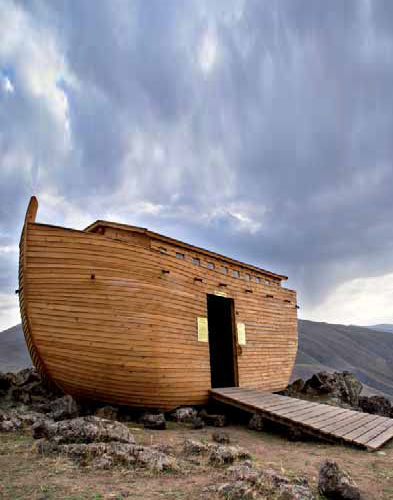“And I will cause it to rain upon the earth forty days and forty nights; and every living substance that I have made will I destroy from off the face of the earth.”GENESIS 7:4

Over 270 accounts of a Great flood exist, told and retold over the ages, and each account marks the flood as the beginning of the civilization that tells the tale. In Judeo--Christian tradition, one of the best-known mentions of the flood is that of Noah’s Ark, a ship built to preserve life on earth, to which the righteous Noah admitted a breeding couple of each animal species, there to weather the forty-day flood along with his family. God had passed judgment on the antediluvians, and decided to wipe their wickedness off the face of the earth by causing rain to fall upon it for forty days and nights, during which "[…] all flesh died that moved upon the earth […] All in whose nostrils was the breath of life, of all that was in the dry land, died.” (Genesis 7:21-2) "[A]nd Noah only remained alive, and they that were with him in the ark.” (Genesis 7:23).
Side by side with these mythological allusions to punitive redemption through extreme weather events, science tells us the Earth's climate has changed over the millennia. During the last Ice Age, around 20,000 years ago, the mean surface temperature on Earth was 5 to 7 °C lower than today’s, and sea level was 100 to 120m below current levels. Some 8,000 years ago, a warm spell took hold, and the Sahara was blanketed by savannas. Later, during the Middle Ages, there was a new period of warmth followed by the "Little Ice Age,” which, among other things, drove the Vikings from Greenland.
We’ve been enjoying an 8,000-year interglacial period, a "long summer” where the climate is stable and that may well have shaped the emergence and development of current civilizations. However, from the 20th century onwards, global mean temperatures have been rising anomalously — too steeply, too fast — and nobody’s quite sure how much we really contribute to global warming, namely due to the emission of greenhouse gases (GHG).
A short time ago, an intense heat wave settled over Russia, causing massive fires. Intense rainfall in Pakistan brought about floods of unprecedented violence. Can these extreme events be ascribed to a common pattern in atmospheric circulation and be driven by the ongoing processes of global warming? Maybe, say scientists The Economist has quoted.
By means of computer simulation, we can now use existing climate models to predict future weather scenarios and assess degrees of vulnerability to climate change throughout the world, along with impacts to social and natural systems, according to geographical, environmental and economic parameters.
In Africa, a high rate of vulnerability is expected. Agriculture on the continent is hardly more than subsistence farming; as rainfall diminishes, deserts expand. In Asia, rising sea levels and an increase in the frequency of cyclones will affect and displace coastal and lowland settlers in densely-populated tropical areas. In South America, as in other regions, more frequent floods and droughts, added to the effects of glacier withdrawal, will produce negative impacts on water resources, agriculture and biodiversity. North America, mostly thanks to greater adaptability, is not as vulnerable. Some tracts in northern Canada may even become arable land.
Regarding Europe, it is the southern areas that will suffer the most from diminished rainfall, long dry spells and a notorious loss of biological diversity. In the Iberian Peninsula alone, annual rainfall could drop 40% and summers may become, on average, 6°C hotter as the century marches on. Northern European countries should be subject to more rainfall, following the trend observed over the past few years.
Given these worldwide changes, Europe especially is to witness more and more extreme weather events and concomitant impact on European economies. There will be more floods and storms, more brush fi res, and public health will be strained by heat waves, bad quality drinking water, inadequate foods and air pollution. As a response to these extreme scenarios, mitigation and adaptation measures adopted under forward-looking EU and international conventions become especially relevant. Not only do we have measures to curtail GHG emissions, but, where floods are concerned, it is of the essence to dampen the negative contribution of certain human activities toward the greater likelihood of floods and their catastrophic toll, stemming mostly from construction projects on floodplains and diminished soil water retention due to the use and impermeabilization of soil.
So lawmakers and regulation authorities recognize that it is not only possible but also desirable to reduce risk associated with climate change and especially with flooding. Floods take a heavy toll on human life and health, on the environment and property. Risk reduction may be achieved through the integrated management of river basins so as to address flood-related risk in a concerted manner.
This has been a concern among insurers and reinsurers who, working alongside relevant authorities, have advocated risk assessment. Their eff orts demonstrate that we need to draw up risk charts detailing risks of coastal and riverine flooding if we are to manage and transfer risk at all. At the local and province level, zoning needs to be reassessed wherever the risk is greatest; finally, we must advocate better building codes.
One can but wonder: did Noah really built the Ark, ensuring the survival of man and beast, or is the biblical tale only an allegory on the salvation of the righteous?
It remains to be seen whether those now living will manage their future with both feet firmly planted on the ground, building their own arks to salvage and redeem what they can from the "wicked ways” of human intervention. I firmly believe that, if they go about it sensibly and systematically, there are and will be sustainable contingency solutions and quantifiable, verified risk transfer schemes.
By Pedro Castro Caldas, Risk Management Consultant
By Pedro Castro Caldas, Risk Management Consultant



